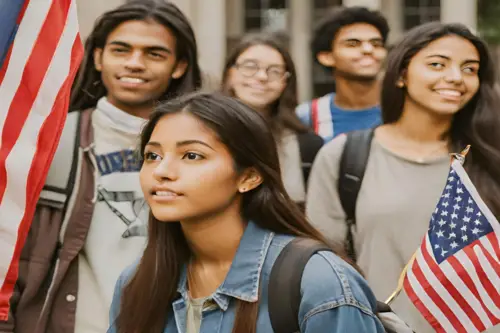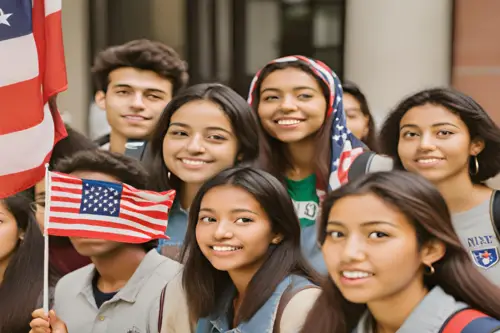Life after an F-1 visa often sparks curiosity about what comes next. If you're an international student gearing up for OPT, already in the zone, or witnessing its conclusion, you're likely pondering, "What's next?"
Many wonder how to transition from an F-1 student visa (or OPT) to something more lasting, like a work visa or green card. I'm here to guide you through this journey in simpler terms. Let's explore together as we unpack the exciting path that lies ahead!
Why OPT Matters in Your Immigration Journey
Knowing how work authorization works is crucial for what comes next. Whether you're getting ready or already in it, this training is the starting point in your US immigration journey.
Discover More About Your Path in the Upcoming Sections
- Experience Accumulation: Gain hands-on experience, enhancing your skills and appealing to potential employers.
- Employer Sponsorship: Leverage your experience accumulation to secure employment, paving the way for potential work visas like the H-1B or O-1 visa.
- Pathway to Your Green Card: Experience gained may contribute to eligibility for specific employment-based green card categories. We also explore other green card alternatives.
1. Experience Accumulation
If you're an international student on an F-1 visa, the term "Optional Practical Training" or OPT might have caught your attention. But what's the fuss about, and why is OPT crucial for your journey from student life to potential work visas or a green card?
The Power of OPT for International Students
Optional Practical Training allows eligible F-1 students to work in the US, aligning with their major of study. It's not just a phase; it's a chance to apply academic knowledge in real-world scenarios.
Key Points to Remember
- Duration: Typically offering 12 months of full-time employment, it lets you decide whether to use it during your academic program or save it for post-graduation.
- Types:
- Pre-Completion: Before completing your degree.
- Post-Completion: Kicking off after graduation.
- 24-month STEM OPT Extension: STEM graduates could seize an additional period of OPT of 24 months. STEM graduates are OPT students who have completed their studies in the fields of Science, Technology, Engineering, and Mathematics (STEM).
- Employment Eligibility: Diverse work alternatives are on the table – multiple employers, short-term gigs, or starting your own venture, as long as they align with your field of study.
Application Process: To embark on OPT, collaborate with your designated school official (DSO) and obtain an Employment Authorization Document (EAD) from USCIS.

Balancing Study and Employment
You’ll be able to work as an international student on an F-1 visa and work in the United States for up to 12 months (or 24 months for STEM graduates) in a field related to your major of study.
During this period, you are generally allowed to work full-time (up to 40 hours per week). In the initial 12-month period, you can work part-time (up to 20 hours per week) while classes are in session.
Full-time work is permitted during official school breaks or the annual vacation term. The STEM extension provides an additional 24 months of work authorization, allowing you to typically work full-time during this period.
It's crucial for you to stay informed about the regulations and guidelines set by the United States Citizenship and Immigration Services (USCIS) to ensure compliance. Adhering to these regulations is important for you to maintain your immigration status.
2. Employer Sponsorship
Your employer becomes a key player when you secure a job. If they're impressed, they might step up to sponsor your work visa, often an H-1B visa. These visas are reserved for roles that demand specialized skills, usually requiring at least a college degree.
There are other employment visa alternatives as well. For example, if you have extraordinary abilities, then you could also pursue an occupational visa called an O-1 visa. The employer's sponsorship paves the way for your US work visa, and who knows?
This could be a stepping stone towards an employment-based green card. So, if you have F-1 status eyeing OPT, the employer sponsorship avenue might be your ticket to the next chapters of your journey.
3. Pathway to Your Green Card
Once you've successfully navigated the complexities of securing an H-1B or O-1 visa and now you're eyeing the possibility of a more permanent stay in the US. What green card paths await you after these accomplishments?
Knowing the details of the types of US immigrant visas is important for making smart choices about your future in the United States. Whether you're moving from an H-1B or O-1 visa, these paths provide different ways to get a green card for permanent residency. Let's delve into the available choices:
1. Employment-Based Green Cards: The Transition to H-1B
- EB-2 and EB-3 Categories: If you hold an H-1B visa, you might consider the employment-based second preference (EB-2) or third preference (EB-3) green cards. The EB-2 is for individuals with advanced degrees or exceptional abilities, while the EB-3 is for skilled workers and professionals.
- Labor Certification Process: To apply for these green cards, your employer typically needs to complete the labor certification process, proving that no qualified US workers are available for your position.
2. Extraordinary Ability Green Card: Elevating to O-1 Visa
- EB-1A Category: If you're transitioning from an O-1 visa, the employment-based first preference (EB-1A) green card is a choice. This category is for individuals with extraordinary abilities in their field, such as outstanding achievements or recognition.
- Self-Petition: One unique aspect of the EB-1A is that it allows for self-petitioning. You can file the petition without employer sponsorship, showcasing your exceptional accomplishments.

3. Family-Sponsored Green Cards: A Broader Perspective
- Immediate Relatives: You can consider talking to a Boston family green card lawyer for family-sponsored green cards. If you have close family members who are US citizens, they may be able to sponsor you as an immediate relative.
- Spouse or Parent Sponsorship: Spouses or parents of US citizens can also explore family-sponsored green cards, providing an alternative route for permanent residency.
4. Diversity Visa Lottery: A Unique Opportunity
- DV Lottery Program: The Diversity Visa (DV) Lottery Program offers a limited number of green cards through a random selection process. If you're from a country with low immigration rates to the US, this could be a unique avenue to explore.
5. Asylum-Based Green Card: Protection for Refugees
- Asylum Status: Individuals granted asylum in the US due to fear of persecution in their home country may be eligible for a green card after one year of asylum status.
6. Marriage-Based Green Card: Love as the Gateway
- Marriage to a US Citizen: If you marry a US citizen, you may be eligible for a green card through marriage. This process involves proving the authenticity of the marital relationship.
7. Investor-Based Green Cards: A Wealth of Opportunities
- EB-5 Immigrant Investor Program: For investors, the EB-5 program offers a pathway to a green card. This requires making a qualifying investment in a new commercial enterprise that creates jobs in the US.
Your Path to Your Green Cards Begins Now!
Now that you've explored different ways to become a permanent resident in the United States, it's crucial to understand each choice. These paths from OPT status offer various ways to get a green card for permanent residency.
Ready to start your OPT journey towards a green card and a more stable future? Connect with us to help you navigate the details of your chosen path. Your quest for permanent residency begins now—seize the chance to shape your future in the land of opportunities!
Posted in: Blog, Green Card, Immigration Law, Visas
